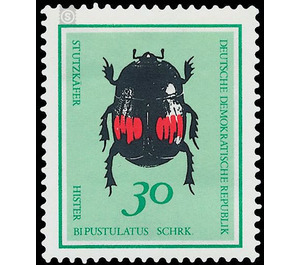Useful beetles - Germany / German Democratic Republic 1968 - 30 Pfennig
Theme: Animals
| Country | Germany / German Democratic Republic |
| Issue Date | 1968 |
| Face Value | 30.00 |
| Color | green |
| Perforation | K 13 1/2: 13 |
| Printing Type | offset |
| Stamp Type | Postage stamp |
| Item Type | Stamp |
| Chronological Issue Number | 1157 |
| Chronological Chapter | GER-DDR |
| SID | 705269 |
| In 18 Wishlists | |
Useful Beetles The Ministry of Posts and Telecommunications of the German Democratic Republic issues six multicolored special postal stamps with pictures of useful beetles. Useful beetles The total number of beetles living in Central Europe is difficult to specify; Sure, there are a few hundred species. The difficulty arises not least from the fact that the concept of usefulness is difficult to define. There are many beetles that play an important role in the household of nature and are therefore indirectly useful. Many Silphidae (carrion beetles) eliminate animal carcasses, the dung beetles bring feces under the ground, Georyssidae and Heteroceridae eliminate organic sludge at pond and stream edges. These are very important and useful activities. This circumstance should not be forgotten when talking about beneficial beetles, because in general one thinks first of all of beetle species that play an important role in the natural control of pests of agriculture or the forest. Many ground beetles (Carabidae) eat the terrestrial pests living on and in the soil, many short - winged (Staphylinidae) and long - tailed beetles (Histeridae) kill fly larvae, not a few beetles (Nitidulidae), flat beetles (Cucujidae), almost all colored beetles (Cleridae) track the pests of the Woods in their brood lobes, ladybirds, the larvae of numerous species of soft beetles (Malachiidae), Cantharidae, Dasytidae, etc.) eat leaf and stem pests. The motif series shows some because of their usefulness to be gentle, but less beneficial as beetle species. 30 Pfennig value: Hister bipustulatus Schranck The two-point beetle Hister bipustulatus Schranck, also under the old name Hister fimetarius Hrbst. led, belongs to the family Histeridae (Stutzkäfer), a beetle group comprising several thousand species. The front and back end of this beetle looks like truncated. Hister bipustulatus Schranck is distributed throughout Europe without the highest north, in Siberia and Asia Minor. The beetles have an extremely hard body wall and are generally hidden. The eggs are usually deposited near carcasses or rotting plant wastes where flies develop. The beetle larvae eat the fly larvae, but also other small insects found in such places. The two-spot beetle has become known as a beneficial factor mainly by the fact that he was constantly encountered in the company of the very harmful Rübenderbrüßlers. Observations showed that the beetle adjusts the Rüßlern and eats them from behind. He squeezes himself under the wings of the pest and eats into the abdomen, while the weevil remains alive for a long time and keeps running.


